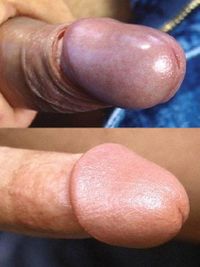Difference between revisions of "Keratinization"
WikiModEn2 (talk | contribs) |
WikiModEn2 (talk | contribs) (Add text) |
||
| Line 2: | Line 2: | ||
[[Image:Keratinization intact vs circumcised.JPG |thumbnail|right|200px| The glans and mucosa of intact and circumcised human penises in adult males.]] | [[Image:Keratinization intact vs circumcised.JPG |thumbnail|right|200px| The glans and mucosa of intact and circumcised human penises in adult males.]] | ||
| − | '''Keratinization''' is the process whereby the surface of the [[glans]] and remaining [[preputial mucosa| mucosa]] of the circumcised penis become dry, toughened and hard. Normally, the glans is covered by the [[foreskin]], which moisturizes the area by [[transudation]], keeping the surface of the glans and inner mucosa moist and supple. After circumcision, however, the glans and surrounding mucosa become permanently externalized, and they are exposed to the air and the constant abrasion of clothing. These areas dry out, causing layers of keratin to build, giving the glans and remaining mucosa a dry, leathery appearance. | + | '''Keratinization''' is the process whereby the surface of the [[glans]] and remaining [[preputial mucosa| mucosa]] of the circumcised penis become dry, toughened and hard. Normally, the glans is covered by the [[foreskin]], which moisturizes the area by [[transudation]], keeping the surface of the glans and inner mucosa moist and supple. After circumcision, however, the glans and surrounding mucosa become permanently externalized, and they are exposed to the air and the constant abrasion of clothing. These areas dry out, causing layers of keratin to build, giving the glans and remaining mucosa a dry, leathery appearance and reducing sensation. |
== Keratin as "Protection" == | == Keratin as "Protection" == | ||
| Line 25: | Line 25: | ||
|pages=899-906 | |pages=899-906 | ||
|url=http://www.ncbi.nlm.nih.gov/pubmed/20098294 | |url=http://www.ncbi.nlm.nih.gov/pubmed/20098294 | ||
| − | |quote= | + | |quote= |
|pubmedID=20098294 | |pubmedID=20098294 | ||
|pubmedCID= | |pubmedCID= | ||
Revision as of 03:10, 19 December 2019
Construction Site
This article is work in progress and not yet part of the free encyclopedia IntactiWiki.
Keratinization is the process whereby the surface of the glans and remaining mucosa of the circumcised penis become dry, toughened and hard. Normally, the glans is covered by the foreskin, which moisturizes the area by transudation, keeping the surface of the glans and inner mucosa moist and supple. After circumcision, however, the glans and surrounding mucosa become permanently externalized, and they are exposed to the air and the constant abrasion of clothing. These areas dry out, causing layers of keratin to build, giving the glans and remaining mucosa a dry, leathery appearance and reducing sensation.
Keratin as "Protection"
It was hypothesized in the past that the layers of keratin resulting from circumcision provided a barrier of protection against sexually transmitted diseases. In 1986, Aaron J. Fink invented the idea that circumcision could prevent the transmission of HIV, arguing that the hard and toughened glans of the circumcised male resisted infection, while the soft and sensitive foreskin and glans mucosa of the intact male were ports of entry.[1]
Recent studies have shown this hypothesis to be false. One study found that there is "no difference between the keratinization of the inner and outer aspects of the adult male foreskin," and that "keratin layers alone were unlikely to explain why uncircumcised men are at higher risk for HIV infection."[2] Another study found that "no difference can be clearly visualized between the inner and outer foreskin." Be that as it may, this hypothesis continues to be popular among researchers who advocate for circumcision as STD prevention.
Higher incidence of HIV infection is found in circumcised men who lack the immunological protection of the foreskin and its Langerhans cells.
References
- ↑ Fink, Aaron J. "A possible Explanation for Heterosexual Male Infection with AIDS." New England Journal of Medicine 315, 18 (1986): 1167
- ↑
 Dinh, MH, McRaven, M.D., Kelley, Z., Penugonda, S., Hope, T.J.. Keratinization of the adult male foreskin and implications for male circumcision. AIDS. 27 March 2010; 24(6): 899-906. PMID.
Dinh, MH, McRaven, M.D., Kelley, Z., Penugonda, S., Hope, T.J.. Keratinization of the adult male foreskin and implications for male circumcision. AIDS. 27 March 2010; 24(6): 899-906. PMID.
